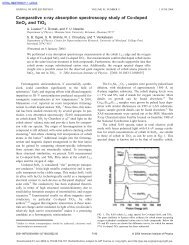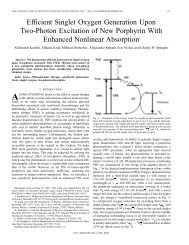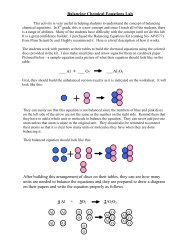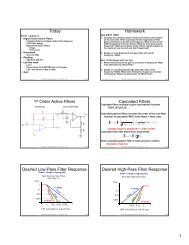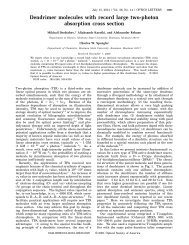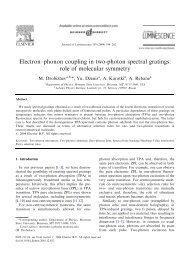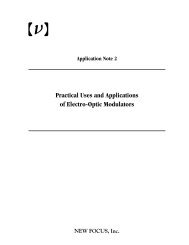Defects in inorganic photorefractive materials and their investigations
Defects in inorganic photorefractive materials and their investigations
Defects in inorganic photorefractive materials and their investigations
You also want an ePaper? Increase the reach of your titles
YUMPU automatically turns print PDFs into web optimized ePapers that Google loves.
<strong>Defects</strong> <strong>in</strong> <strong>in</strong>organic <strong>photorefractive</strong> <strong>materials</strong> <strong>and</strong> <strong>their</strong> <strong>in</strong>vestigations 3<br />
oxygen vacancy. If the charge of the defect is to be <strong>in</strong>dicated, a correspond<strong>in</strong>g<br />
superscript is added. Sometimes the charges are referred to that of the replaced<br />
ion, then Bi x Si is used for an antisite defect, if the replac<strong>in</strong>g <strong>and</strong> the replaced ion<br />
have the same charges. If the replac<strong>in</strong>g one is negative (positive), the notation<br />
is Bi ′ Si (Bi• Si ). Also the label Bi4+<br />
Si<br />
, <strong>in</strong>dicat<strong>in</strong>g the electronic configuration of the<br />
defect ion, may be used for the neutral case <strong>and</strong> Bi 3+<br />
Si<br />
(Bi 5+<br />
Si<br />
) for the negative<br />
(positive) one. For an overview on defect notations see Ref. [3].<br />
Fig. 1. Def<strong>in</strong>ition of defect levels,<br />
illustrated with the three basic<br />
models for charge transfer between<br />
defects <strong>in</strong> <strong>photorefractive</strong><br />
crystals [4]. The special cases are<br />
shown, where electrons are transferred<br />
from the valence b<strong>and</strong> to<br />
the defect levels. Electron transfer<br />
from defect levels to the conduction<br />
b<strong>and</strong> would lead to complementary<br />
schemes. Double arrows<br />
<strong>in</strong>dicate light-<strong>in</strong>duced transfer,<br />
s<strong>in</strong>gle arrows recomb<strong>in</strong>ation<br />
of a defect electron with a valence<br />
b<strong>and</strong> hole. a): one - center<br />
model: under illum<strong>in</strong>ation the total<br />
concentrations X 0 <strong>and</strong> X − are<br />
not changed. The model therefore<br />
does not lead to photochromicity.<br />
b, c): Here the shallow levels are<br />
metastably populated after optical<br />
excitation. The concentrations<br />
of the defect charge states change,<br />
lead<strong>in</strong>g to photochromicity.<br />
As a consequence of the broken translational symmetry, defects can <strong>in</strong>troduce<br />
levels <strong>in</strong> the gap between valence <strong>and</strong> conduction b<strong>and</strong>, which represent<br />
the eigenenergies of an ideal crystal. Depend<strong>in</strong>g on the position of the Fermilevel<br />
<strong>in</strong> the crystal, such defect levels may be occupied by electrons or be<br />
empty. For oxide <strong>materials</strong>, reduction <strong>and</strong> oxidation are convenient means to<br />
shift the Fermi-level. The <strong>photorefractive</strong> effect is based on the fact that the<br />
level population can also be changed by illum<strong>in</strong>ation, especially <strong>in</strong> oxide <strong>materials</strong><br />
often <strong>in</strong> a metastable manner. A level <strong>in</strong>troduced by a defect X, where<br />
the charge state ’0’ is assumed to coexist with the charge state ’-’ , is labelled<br />
X 0/− (Fig. 1), <strong>in</strong> analogy to the notation for redox-pairs <strong>in</strong> electrochemistry,<br />
see e.g. [5]. This means: if the level lies at an energy E X above the valence





